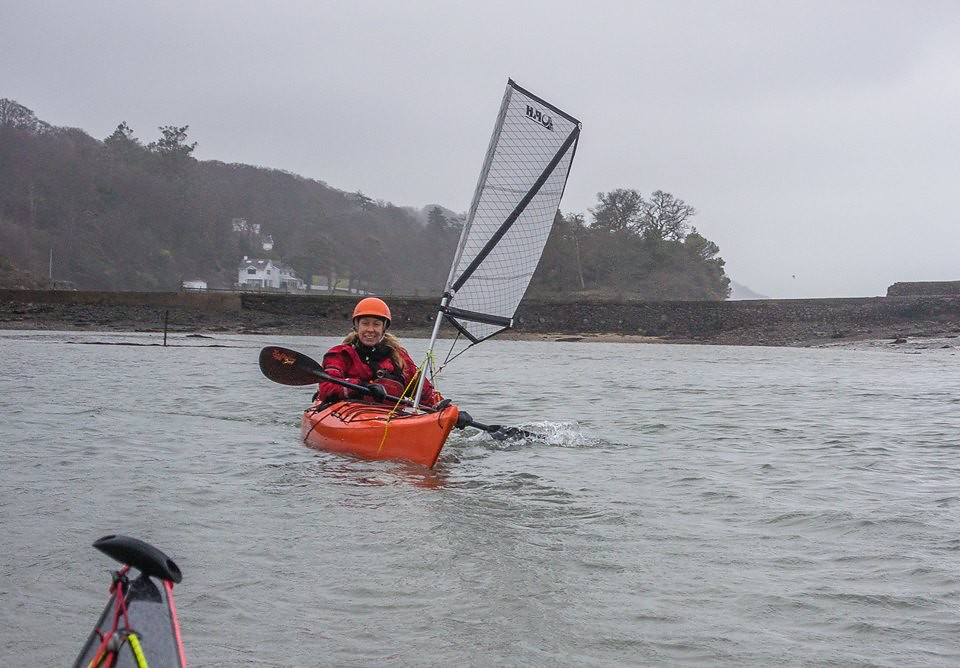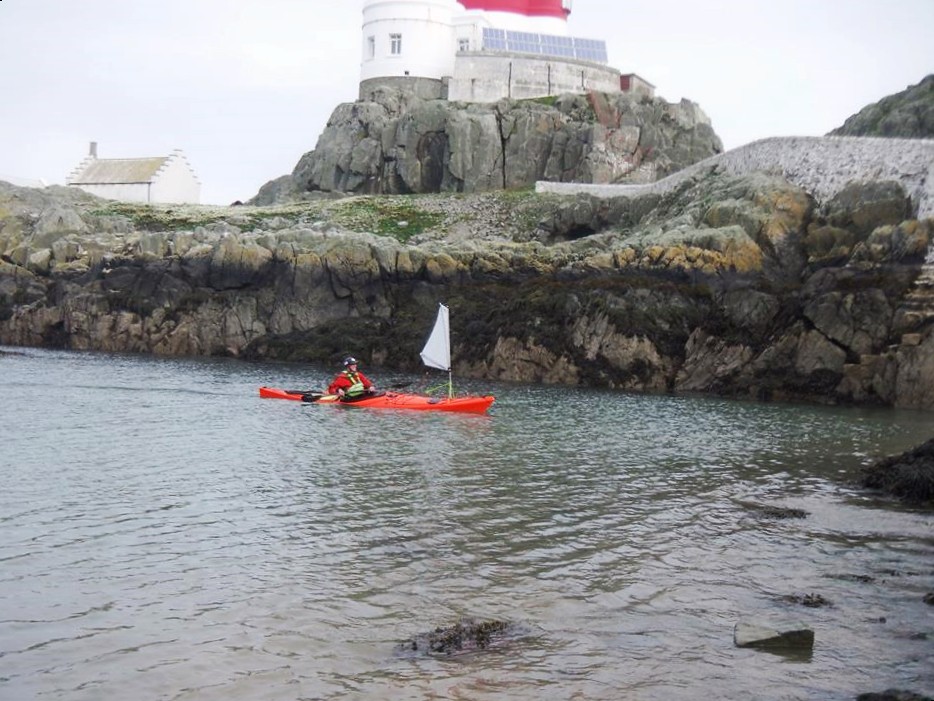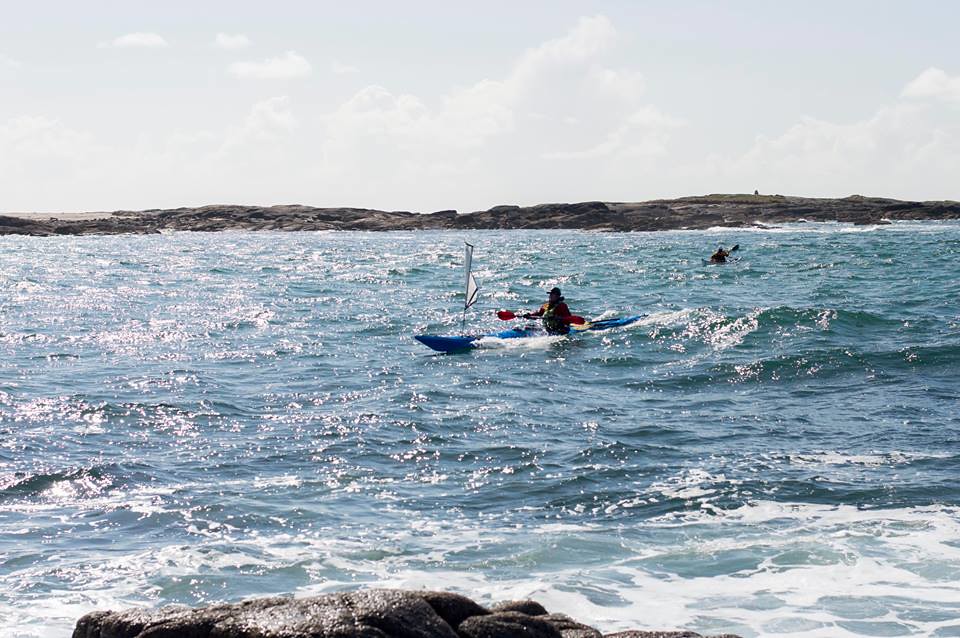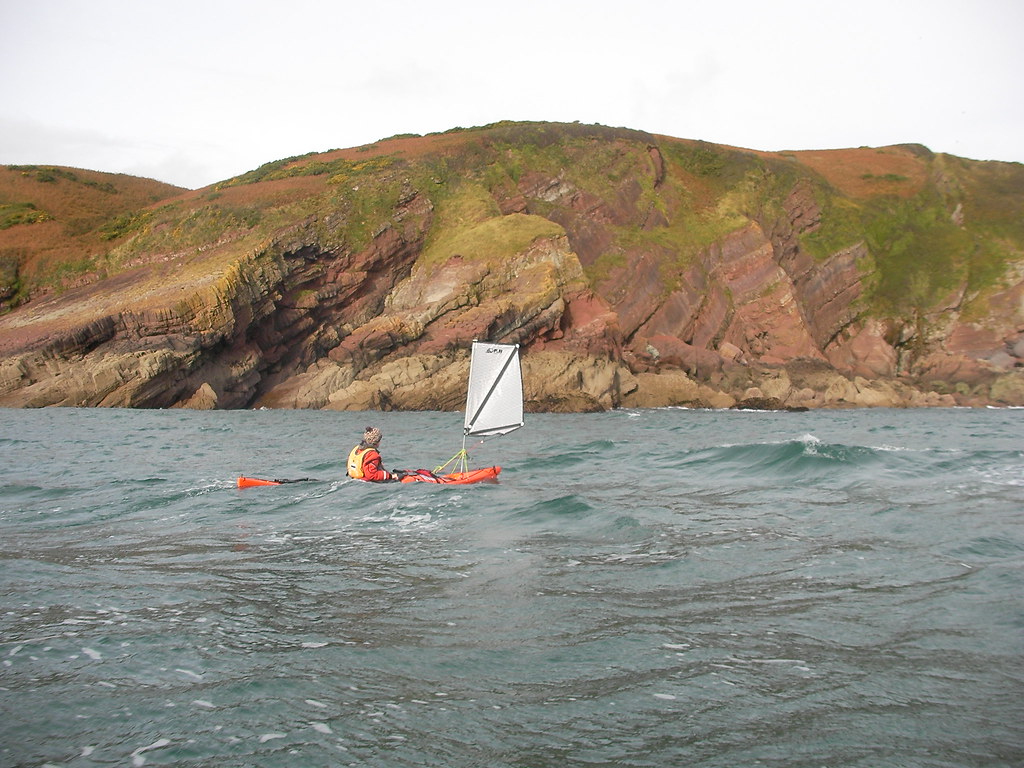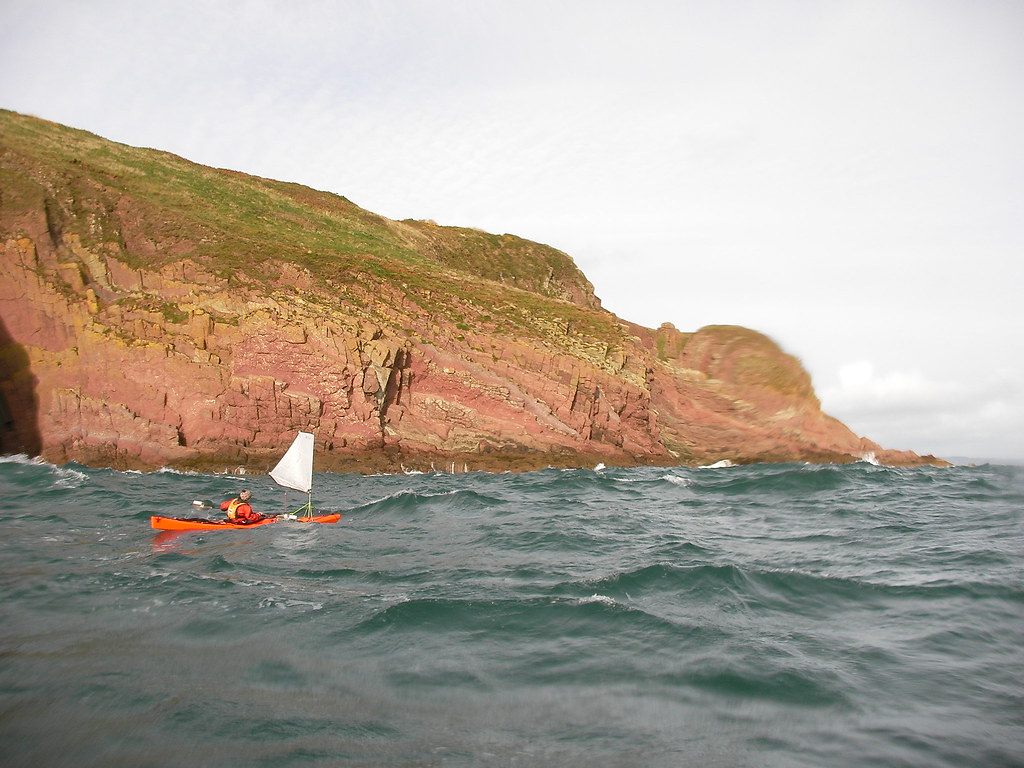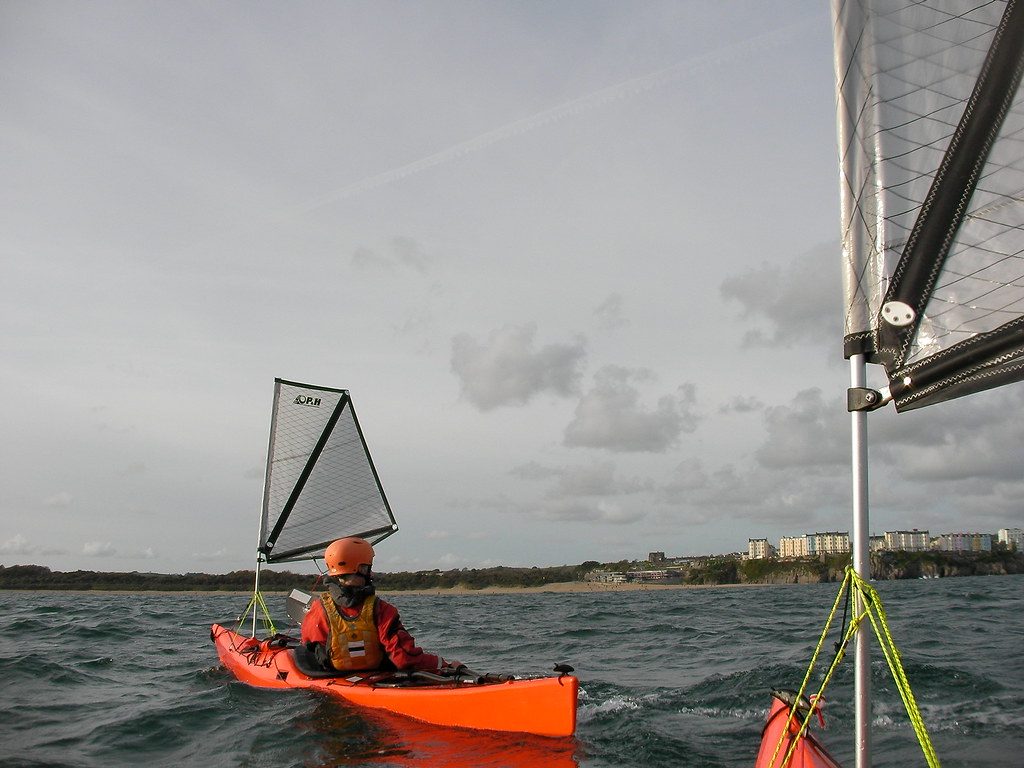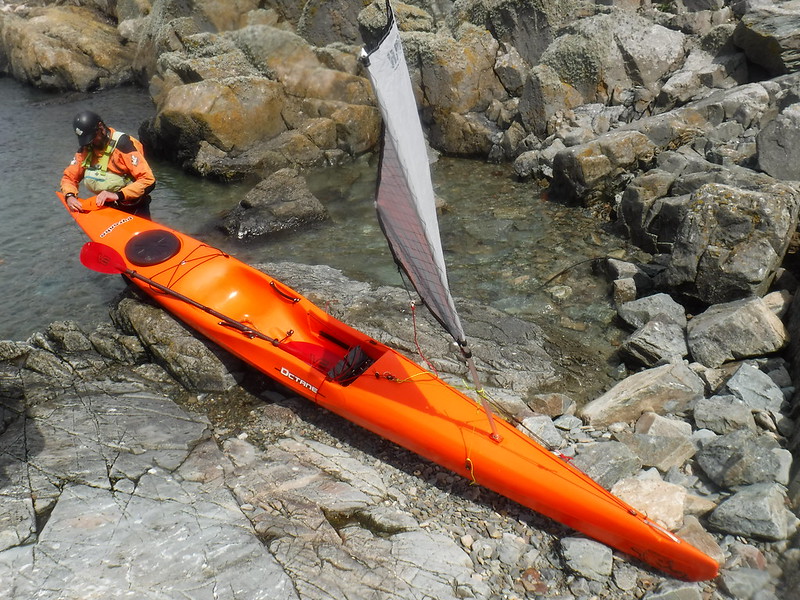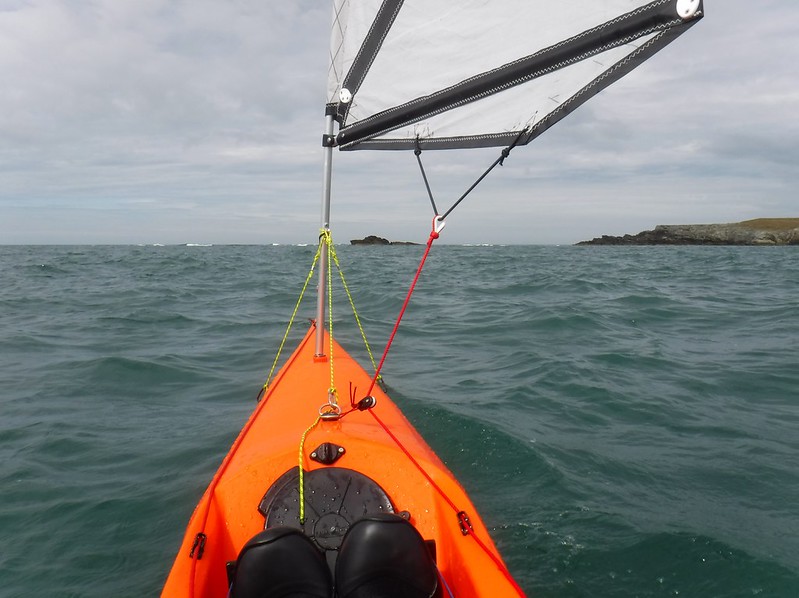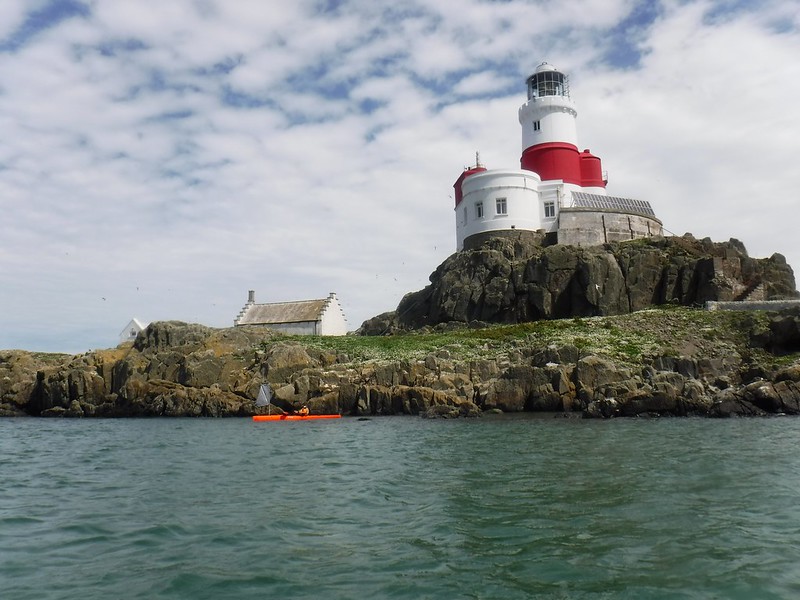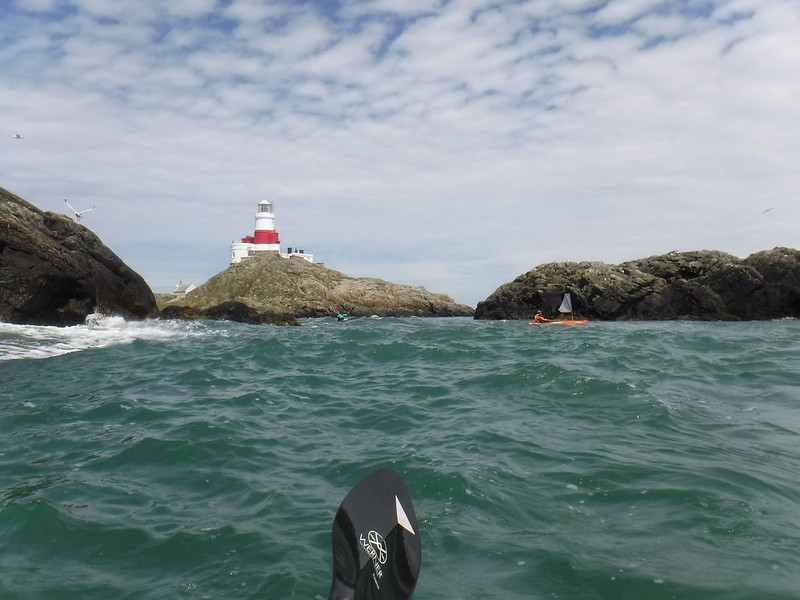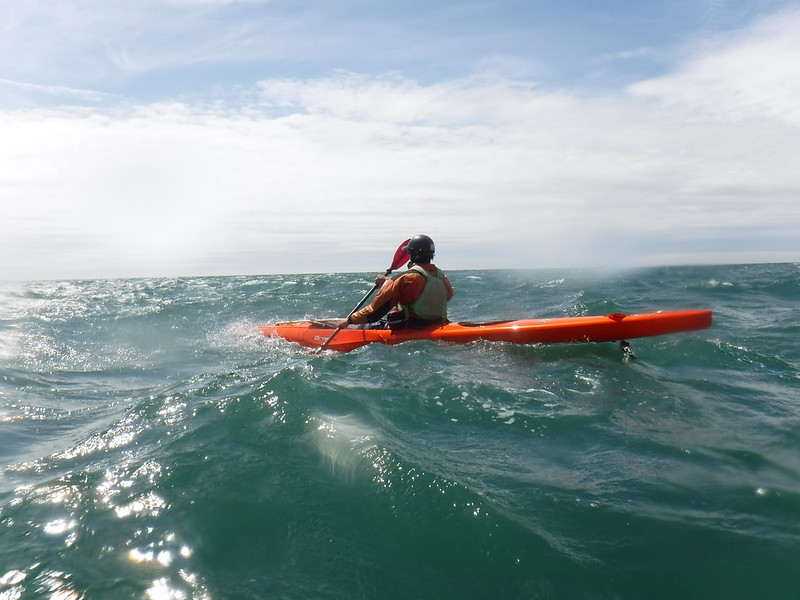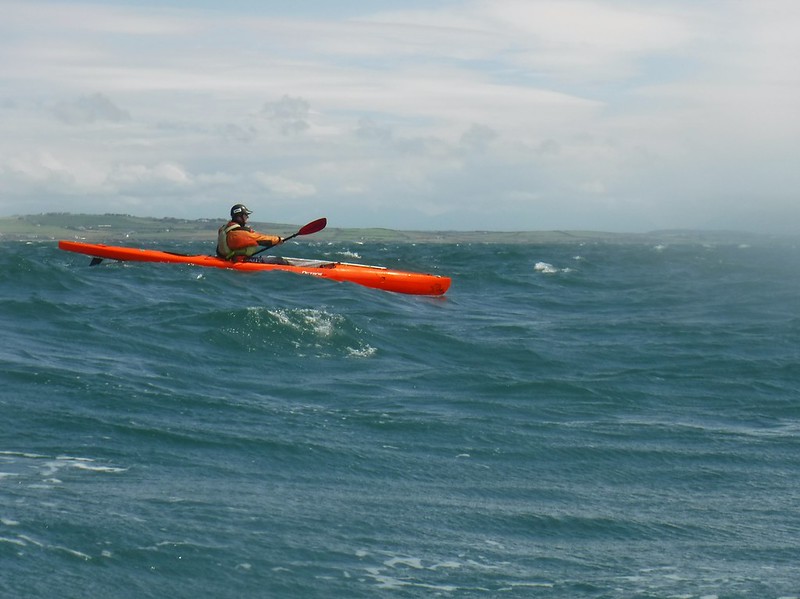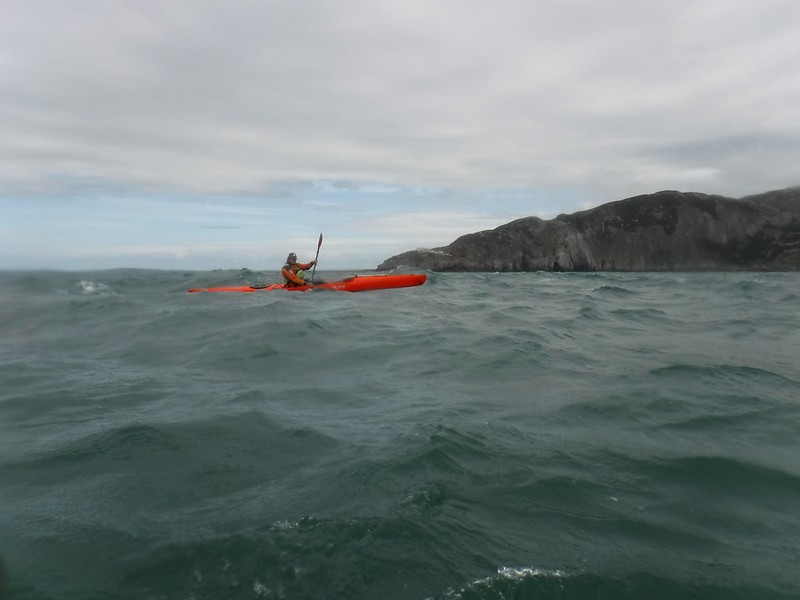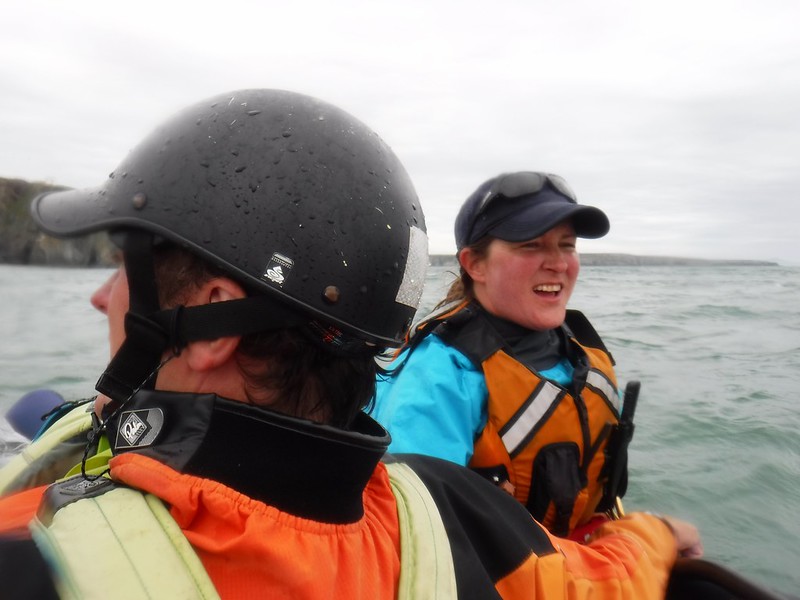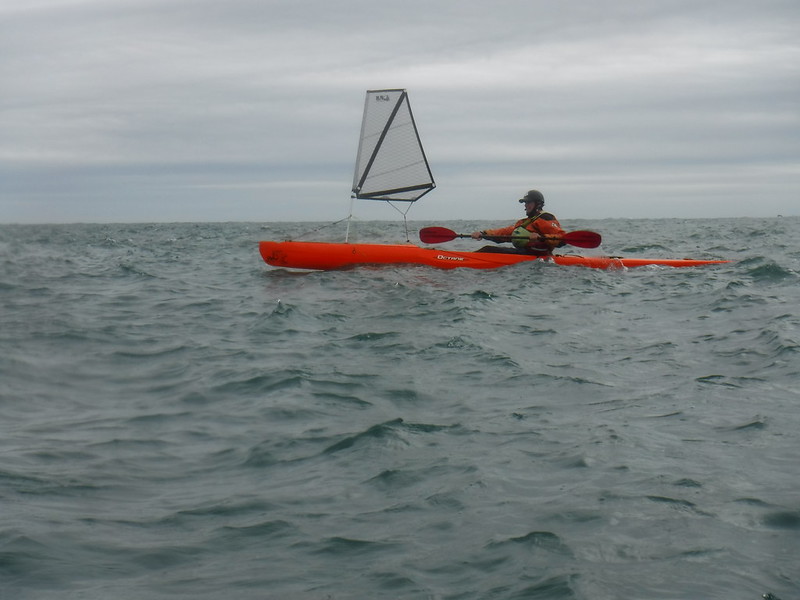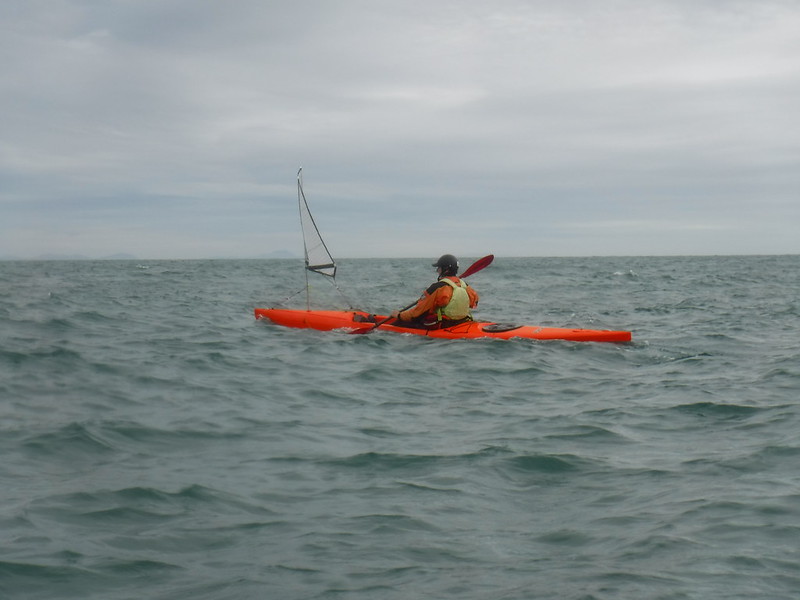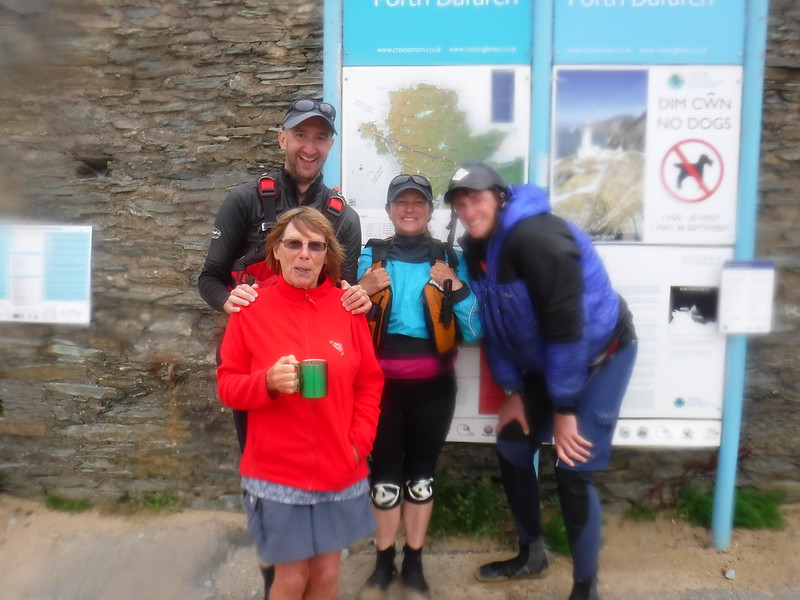It has been a while since we have been on the water together. So today, we planned a little daytrip to Northern France, more specific Cap Gris Nez. It is located along the Dover Strait (Pas de Calais) on the French side of course and is known for its strong tidal current and fast changing weather. We planned on paddling near the rocks and cliffs around high water. While it was very sunny the first part of the trip, weather began to change very fast (within 30 minutes) and a sea fog set out all over the area. When in the neighbourhood with a kayak on the roof of your car, make sure to stop by and enjoy the scenery (and meet the grey seals that live there)!
Month: July 2016

South Pembrokeshire
West Coast of Ireland
Sea kayaks enable their users to explore and play on life-affirming journeys. Part of the challenge is to safely utilise the currents, swell and winds. The direct energy of the wind has been largely unused by most modern sea kayakers. In recent decades sailing rigs have become far more manageable to use on sea kayaks and their distribution/availability outside of Australia and New Zealand is only now becoming a reality. This exciting development is opening up brand new sea kayaking opportunities and challenges for all. From downwind coastal runs to traversing huge exposed island chains, like the Aleutians, sea kayak sailing is putting bigger smiles on people’s faces and aiding in epic journeys.
Tropical beach on Caldey Island
Windy day at Cadnant Bay Menai Straits
History
Kayak sailing was invented in 1865 when John “Rob Roy” MacGregor designed and built a sailing kayak for his 1,000 mile journey along the inland waterways of Europe. Those early Rob Roy Kayaks subsequently evolved into the huge variety of kayak types that we know today. Sail equipped kayaks remained popular into the 1930s. In 1934, Alastair Dunnett and Seumas Adam (“The Canoe Boys”) used their sail equipped Lochaber kayaks on an impressive and pioneering journey to explore the west coast of Scotland.
Kayak sailing also became popular in continental Europe during the 1920s and 1930s. In 1928 Franz Romer kayak sailed across the Atlantic from Lisbon to Puerto Rico. He attempted to continue his journey onwards to New York but went missing, presumably killed, in a hurricane. Oskar Speck’s similarly epic seven year kayak sailing trip from Germany to Australia should have been widely celebrated as an amazing achievement. However, arriving at his destination in September 1939 he was interned for the duration of the Second World War.
Kayak sailing subsequently went out of fashion in Europe. Towards the end of the twentieth century sails were beginning to be developed for use on modern sea kayaks by Australia and New Zealand-based kayakers. Sea kayak sailing is now commonplace in these countries and is beginning to take hold in Europe and North America.
Skerries Lighthouse, Anglesey
Surfing in Ireland
Surfing near Stackpole
Why sea kayak sail?
- Speed/endurance/fun
Maintaining the top displacement hull speed is easier when sea kayak sailing. It is also much easier to get your kayak planing in swell and tidal rapids. This is particularly useful when attempting to catch less steep waves. In essence you will catch more waves, considerably increasing your speed and range. Average speeds of 7 knots with planing top speed runs in excess of 10 knots are not unusual in conditions where it would be considerably more difficult for conventional sea kayaks to plane and maintain average speeds of more than 3-4 knots.
When the waves become too steep it is best to stow the sail away as it will no longer enhance the experience and will, most likely, become a liability.
- Enhanced safety
The sail appears triangular and conspicuous from afar and/or in overhead rolling swell.
The exposure of paddling along coastlines with less frequent safe landings is reduced if the wind and sail combine to add to the kayaks propulsion.
Caldey Island tiderace
Getting into sea kayak sailing
Equipment
The main airfoil sail available in Europe is the Flat Earth Kayak Sails range of airfoils. They are designed and manufactured in Australia by Mick MacRobb. Other airfoil sails are being manufactured for sea kayaks but they are far less common in Europe.
Sea kayak manufacturers
Many composite sea kayaks will need strengthening in order to accommodate a sail mast. You can assess this by pressing down on the deck near the compass recess and gauging whether there is much flexibility in the deck and hull. Most kayak companies will strengthen your kayak by special order. Plastic kayaks tend to be more robust in taking a sail mast.
Since 2012, P&H kayaks have produced all of their composite kayaks with enough strength to accommodate a sail mast. Their plastic Scorpio MKII range of sea kayaks has been designed with sailing in mind. It easily accommodates a Flat Earth Sail and handles superbly well when sailed.
Have a go/purchase
Scotland – Karitec are the main UK distributor of Flat Earth Kayak Sails and have a range of demo boats to try out under sail.
England – P&H have demo kayaks fitted with sails and attend many sea kayak symposiums.
Wales – Sea Kayaking Wales (SKW) are based on Anglesey and have a range of P&H sea kayaks and Flat Earth Kayak Sails to try out. SKW also run sea kayaking (including sailing) courses in Ceredigion, Pembrokeshire, Llŷn and the Gower. Flat Earth Sails are available to purchase from SKW.
More Information
http://seakayakphoto.blogspot.co.uk/ – An excellent blog written by, Douglas Wilcox, one of the most enthusiastic proponents of sea kayak sailing in Europe.
http://www.flatearthkayaksails.com/ – The most popular airfoil sail in the UK at present.
Tenby
Geth
www.seakayakingwales.com
After paddling the Octane on Llyn Padarn I wanted to try it out at sea in wind, waves and moving water. My kayaking buddies for this trip were Ed and Abi Loffil.
The Pyranha Octane with the Flat Earth Sail fitted
Ed and Abi had a head start on the outward leg so I followed them 20 minutes after their departure. This leg had up to 10 knots of southerly wind with a slightly post spring tidal current to propel us on the flooding tide to The Skerries. Time of leg – 1.5 hrs.
Approaching Penrhyn Mawr
Approaching the middle race of Penrhyn Mawr
South Stack
Rush Hour in Holyhead Bay
The Skerries
Departing The Skerries
Surfing circuits at The Skerries
The return leg had 10-17 knots of southerly wind against the south flowing ebb tide. Time of leg – 3 hrs.
The rough journey back south
North Stack
Taking a rest at South Stack
Sailing home to Porth Dafarch
The team returned at Porth Dafarch with our paddling friend Jan
Initial thoughts on the Octane
Previous to receiving the Octane I had never paddled a surfski. The closest speedy boat I had experienced to compare it to is the Rockpool Taran. The Octane, like the Taran, is great fun to paddle fast, especially in surf. At speed the surf ski is particularly stable, locking into its watery path. Its stability seemed further enhanced with the addition of the Flat Earth Sail, as this gave more propulsion. It is even better to sail than the equivalent P&H Scorpio or Delphin sailing kayaks as it is super quick and responsive to the rudder. With its open cockpit it felt a lot like a modern sailing dinghy, especially with the gurgling sound of the self-bailer.
Paddling downwind with swell was far, far better than the reverse into wind and waves. The former situation gave much greater speed than the accompanying sea kayaks, whereas into wind and swell the surfski was only marginally quicker, despite lots more effort from my core muscles. I probably need to improve my technique in these conditions.
The Octane is a very positive boat. It rewards good posture and technique with better performance. This feedback is proving really useful as I try to get better at paddling a surf ski.
Next time I want to try some more downwind runs!
Geth
When I was looking to replace my trusty P&H Scorpio Lv with a Cetus I spend hours looking on the internet to find footage where I could see the boat in action. I know what you’re thinking, why not testing it rather that looking at videos? Well, I already did and I was sure that the Cetus was going to be my next boat. The kayak customizer page on the P&H site is awesome, I think I made my boat virtually one hundred times. But it’s even better to see the boat on the water, with a paddler in it. To see it’s colours, to see the different options, to see its behaviour,… Even when waiting on the delivery I searched “Cetus videos”. The only downside was that there are not many to be found where you can see the boat from different angles. So I remained a bit unsatisfied for the time being…
With the delivery I felt like a kid with his new toy (and I still am by that matter). It was my first composite boat, new, shiny, glossy! I already paddled several hundred kilometres with it, in a wide variety of conditions. Just like its polyethylene brother, the Scorpio, it never lets me down. On the water it has to perform, it goes fast while being stable, very stable. Even when paddling in rough seas it still feels like I am paddling from my couch. When putting it on edge it steers and turns very well. Anyway, don’t take my word for it. I am perhaps a tiny bit subjective. When looking to buy a quality sea kayak, make sure to test this piece of craftsmanship and see for yourself!
Enjoy our short video, a big thanks to Sylvie, who filmed from different angles to get the best result.
Paddle safe and take care of each other on the water!
Dimitri Vandepoele
NORTHSEAKAYAK
The British public have spoken, and they’ve elected to leave the European Union.
The full effects of Brexit are yet to be seen, and this resultant uncertainty in the UK’s political climate has led to a significant fall in the value of the Pound in relation to both the Dollar and the Euro.
For non-UK manufacturers, this means their products have become much more expensive when imported to the UK market, whereas our products (proudly made in the UK since 1971) have remained at the same price to our UK customers, and are now even better value to those in the US, EU and further afield.
However, this won’t last; although we manufacture all of our products in the UK, many of the raw materials and much of the packaging are oil-based, and as oil is traded in Dollars, the cost of these is sure to rise in the next few months once our pre-agreed contract pricing comes to an end.
If you’re asking yourself, ‘Is now the right time to buy a kayak?’, the answer is a resounding yes, as no one can predict by how much prices of the raw materials that go in to a kayak will rise, but as the margins we make on them is minimal, these price rises are sure to affect the consumer.
There has never been a better time to buy a British Canoe or Kayak, check out the P&H Sea Kayaks range now.



